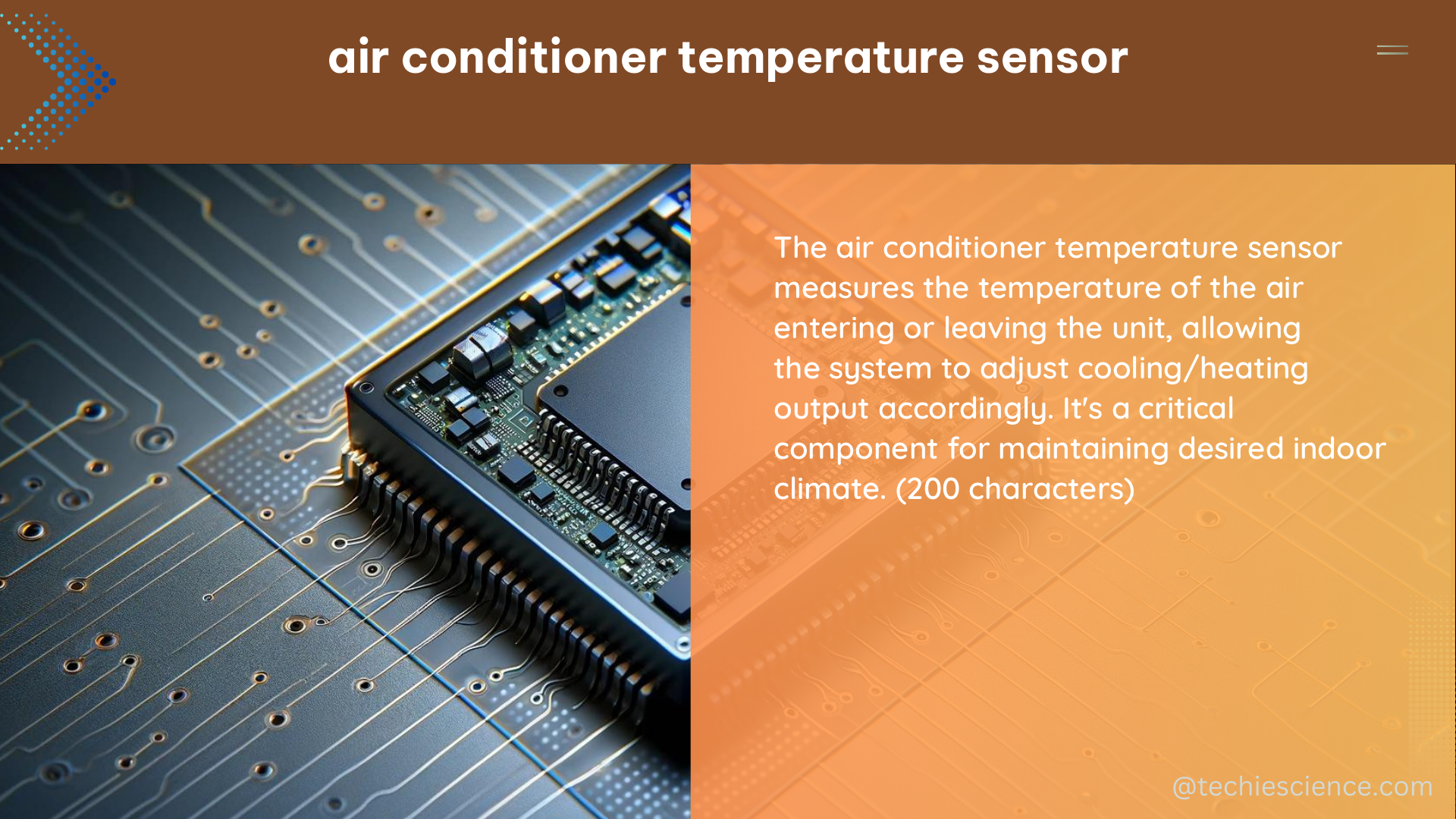The air conditioner temperature sensor is a vital component in an air conditioning system, responsible for precisely measuring the temperature of the air inside the room and providing real-time feedback to the system’s control mechanism. This information enables the air conditioner to dynamically adjust its cooling output, ensuring the desired temperature is maintained with exceptional accuracy.
Understanding Temperature Range
The temperature range of an air conditioner temperature sensor refers to the specific span of temperatures that the sensor can accurately measure. This range is typically specified in degrees Celsius (°C) or Fahrenheit (°F). For example, a high-performance temperature sensor may have a range of -40°C to +125°C (-40°F to +257°F), allowing it to precisely monitor temperatures across a wide spectrum.
| Temperature Range | Accuracy |
|---|---|
| -40°C to +125°C (-40°F to +257°F) | ±0.5°C (±0.9°F) |
| -20°C to +80°C (-4°F to +176°F) | ±0.3°C (±0.5°F) |
| 0°C to +50°C (+32°F to +122°F) | ±0.2°C (±0.4°F) |
It’s important to select a temperature sensor with a range that encompasses the expected operating temperatures of the air conditioning system to ensure accurate and reliable performance.
Sensor Accuracy

Accuracy is a crucial specification that determines how closely the temperature sensor’s measurements match the actual temperature. This is typically expressed as a percentage of the full-scale range or in degrees Celsius or Fahrenheit.
For example, a temperature sensor with an accuracy of ±0.5°C can measure temperatures within 0.5°C of the true value. The higher the accuracy, the more precise the sensor’s readings will be, allowing the air conditioning system to maintain the desired temperature with greater efficiency.
Response Time
Response time refers to the time it takes for the temperature sensor to react to changes in the surrounding air temperature. This is typically measured in seconds or milliseconds. A faster response time enables the sensor to more quickly and accurately track temperature fluctuations, allowing the air conditioning system to respond more promptly to maintain the set temperature.
| Response Time | Typical Applications |
|---|---|
| < 1 second | High-performance HVAC systems, industrial process control |
| 1-5 seconds | Standard residential and commercial air conditioning systems |
| 5-10 seconds | Basic air conditioning units, low-cost temperature monitoring applications |
Selecting a temperature sensor with a response time that matches the specific requirements of the air conditioning system is crucial for optimal performance and temperature control.
Power Requirements
The power requirements of an air conditioner temperature sensor refer to the amount of electrical power the sensor needs to operate. This is typically expressed in milliwatts (mW) or watts (W). Lower power requirements are generally preferred, as they have less impact on the overall power consumption of the air conditioning system.
| Power Requirement | Typical Applications |
|---|---|
| < 10 mW | Battery-powered or energy-efficient air conditioning systems |
| 10-100 mW | Standard residential and commercial air conditioning systems |
| > 100 mW | High-performance HVAC systems with advanced control features |
Considering the power requirements of the temperature sensor is essential when integrating it into the air conditioning system, especially in energy-efficient or battery-powered applications.
Sensor Durability and Compatibility
In addition to the technical specifications, it’s crucial to consider the durability and compatibility of the air conditioner temperature sensor. The sensor should be able to withstand the rigors of continuous operation in various environmental conditions, such as temperature extremes, humidity, and vibration.
Furthermore, the sensor must be compatible with the control mechanism and other components of the air conditioning system. This ensures seamless integration and reliable performance throughout the system’s lifespan.
DIY Installation and Maintenance
When it comes to DIY installation and maintenance of air conditioner temperature sensors, it’s essential to follow the manufacturer’s instructions carefully. This may involve tasks such as:
- Proper wiring and soldering connections
- Adjusting screws or bolts for secure mounting
- Calibrating the sensor using a reference thermometer
- Verifying the sensor’s accuracy and response time
Attention to detail and adherence to the manufacturer’s guidelines are crucial to ensure the temperature sensor is installed and functioning correctly, enabling the air conditioning system to maintain the desired temperature with optimal efficiency.
Conclusion
The air conditioner temperature sensor is a critical component that plays a pivotal role in the performance and efficiency of an air conditioning system. By understanding the key specifications, such as temperature range, accuracy, response time, and power requirements, you can select the right sensor for your specific needs and ensure your air conditioning system operates at its best.
Remember, proper installation and maintenance of the temperature sensor are essential for maintaining optimal cooling performance. By following the manufacturer’s instructions and leveraging the technical details provided in this comprehensive guide, you can master the air conditioner temperature sensor and enjoy a comfortable, energy-efficient indoor environment.
References:
- MIL-STD-881F_Final.pdf
- California_Evaluation_Framework_June_2004.pdf
- Why isn’t my A/C keeping up? I question answered by my fantastic A…

The lambdageeks.com Core SME Team is a group of experienced subject matter experts from diverse scientific and technical fields including Physics, Chemistry, Technology,Electronics & Electrical Engineering, Automotive, Mechanical Engineering. Our team collaborates to create high-quality, well-researched articles on a wide range of science and technology topics for the lambdageeks.com website.
All Our Senior SME are having more than 7 Years of experience in the respective fields . They are either Working Industry Professionals or assocaited With different Universities. Refer Our Authors Page to get to know About our Core SMEs.